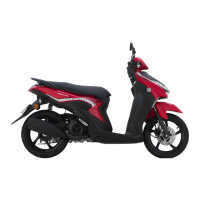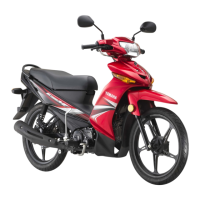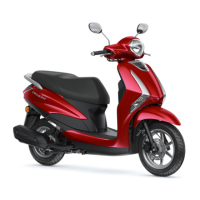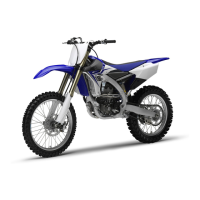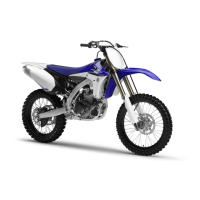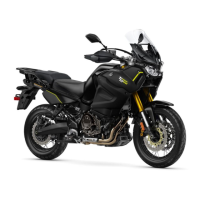Do you have a question about the Yamaha Ego Avantiz and is the answer not in the manual?
Owner's responsibility for safe scooter operation and rider qualifications.
Guidelines for safe riding practices and vehicle condition checks.
Essential protective clothing to minimize injury risk in accidents.
Dangers of carbon monoxide from exhaust and prevention measures.
Guidelines for safely adding cargo and accessories without affecting stability.
Importance of using genuine Yamaha accessories for safety and performance.
Risks and considerations when using non-genuine parts or making modifications.
Precautions regarding the use of non-standard tires and rims for safety.
Proper procedures for securing the scooter during transport.
Additional tips for safe riding in various conditions and situations.
Importance, selection, and correct wearing of motorcycle helmets for head protection.
Identification of various parts and components on the left side of the scooter.
Identification of various parts and components on the right side of the scooter.
Overview of the scooter's handlebar controls and instrument panel layout.
Operation of the ignition switch, steering lock, and seat opening function.
How to open and close the keyhole cover on the main switch.
Explanation of dashboard indicator lights and warning signals.
Description of the speedometer, odometer, and fuel meter functions.
Identification and operation of switches on the left and right handlebars.
Location and operation of the front brake lever.
Location and operation of the rear brake lever.
How to engage and disengage the rear brake lever lock.
Procedure for removing and installing the fuel tank cap.
Recommended fuel type, tank capacity, and refueling safety precautions.
Information about the catalytic converter and safety precautions.
How to use the kickstarter to start the engine if the electric starter fails.
How to open and close the scooter's seat.
Location and use of helmet holders under the seat.
Location and load limits for the convenience hook.
Information on the under-seat storage compartment and its usage precautions.
Location and operation of the sidestand.
Explanation of the sidestand switch's role in the ignition system.
Step-by-step guide to starting the scooter's engine.
How to control speed using the throttle for acceleration and deceleration.
Proper braking techniques, including warnings for wet conditions.
Recommended procedures for breaking in the engine during the initial period.
Instructions for safely parking the scooter, including engine off and key removal.
Benefits of proper use and maintenance for optimal performance and longevity.
Location and purpose of the tool kit for basic maintenance.
Procedures for removing and reinstalling body panels for maintenance access.
How to inspect and check the spark plug for engine condition.
Procedures for checking, changing engine oil, and cleaning the oil strainer.
Instructions for checking and changing the final transmission oil.
Maintenance procedures for air filter elements and V-belt case filter.
Checking engine idling speed and adjusting throttle grip free play.
Information on valve clearance adjustment, typically done by a dealer.
Importance of tire and wheel condition, inspection, and replacement for safety.
Checking brake levers, pads, shoes, fluid level, and performing adjustments.
Checking and lubricating the V-belt, cables, and throttle grip.
Lubricating brake levers, centerstand, sidestand, and checking front fork.
Checking steering bearings for wear and inspecting wheel bearings.
Information on battery maintenance, charging, and storage.
Procedures for replacing fuses and light bulbs, including troubleshooting.
A guide to diagnose common starting problems with the fuel, battery, ignition, or compression.
General guidance on cleaning the scooter to prevent rust and corrosion.
Procedures for short-term and long-term storage of the scooter.
Location of vehicle and engine serial numbers for identification and record-keeping.
| Engine Type | Air-cooled, 4-stroke, SOHC, 2-valve |
|---|---|
| Displacement | 125 cc |
| Bore x Stroke | 52.4 mm x 57.9 mm |
| Compression Ratio | 9.5:1 |
| Fuel System | Fuel Injection |
| Ignition System | TCI |
| Transmission | V-belt automatic |
| Front Suspension | Telescopic fork |
| Rear Suspension | Unit swing |
| Rear Brake | Drum |
| Rear Tire | 90/80-14M/C 49P |
| Fuel Tank Capacity | 4.2 liters |
| Wet Weight | 96 kg |
| Overall Length | 1, 870 mm |
| Overall Width | 685 mm |
| Front Brake | Hydraulic single disc |
| Maximum Power | 7.0 kW (9.5 PS) @ 8, 000 rpm |
| Maximum Torque | 9.6 Nm (0.98 kgf·m) / 5, 500 rpm |
